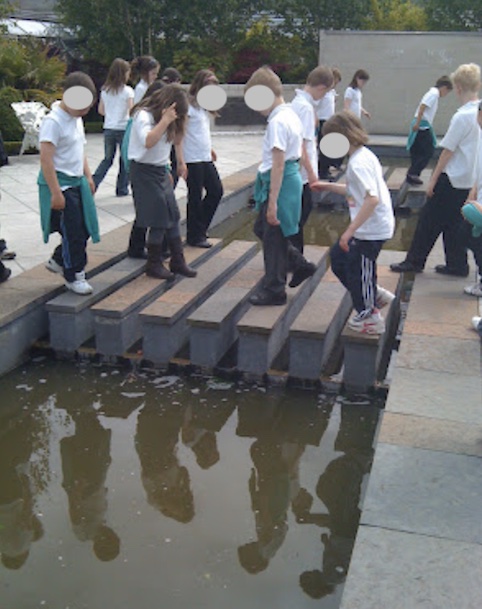Here in Scotland, our younger children are expected to have fun creating a range of symmetrical pictures and patterns using a range of media. Immediately the outdoor possibilities of such experiences run riot in my mind where the explorations can be bigger, better and different.
Before mirrors are handed out or put up outside, reflections can be explored and are sources of interest and fascination to children. Do you remember the Greek legend of Echo and Narcissus? At this time of year with daffodils blooming, it’s a seasonal connection as Narcissus became a daffodil when he wasted away looking at his own reflection in a pool of water.
It is really helpful, as an early years practitioner, to be able to tune into your own landscape and neighbourhood, to see the diversity and range of reflections that exist. It is also worthwhile taking photos of interesting reflective surfaces and public works of art, to draw your children’s attention to what the concept of reflection means.
In this blog post, I’ve simply assembled examples from my own photo collection to illustrate what is out there!

In Blackpool, children are particularly lucky in that right in the centre of the town is this amazing sculpture, The Wave by Lucy Glendinning: The photo below is a bit dark as it was taken late afternoon in winter, so click on the link above to really enjoy the detail of this public artwork.

Whilst you won’t have this near you, perhaps it may inspire you and a group of children to see if you have any “wavy” reflective surfaces:
- Perhaps a bumpy slide in a park?
- Or moving river with ripples – are ripples waves?
- How about window that is circular and distorts the image?
- Do you have examples of convex mirrors outside?
Blackpool is also home to the world’s largest glitter ball. 47,000 mirror tiles create dramatic reflective light patterns on the promenade.

Again, you may not have this example on your doorstep, but someone may have a hand-sized glitter ball you can look at and wonder about.
Of course, other countries have very interactive reflective sculptures. Look at The Bean in Chicago. It’s official name is “Cloud Gate” and it was designed by British artist Anish Kapoor:
By now your group may have begun to work out that reflective surfaces are easily distorted and true mirror reflections are quite unique outside.
Not to be outdone, Linköping, a Swedish town, has a reflective sculpture that you can clamber and climb on. It was designed by Monika Gora and is called Metamorfos! Its surface reflects everything around it, being made of stainless steel and having seven hills.

Reflections represent beauty, intrigue, exploration and investigation. After finding out about all the reflective surfaces in your own neighbourhood, a few art activities, indoors or out are a must! Let children reflect on reflections!
This blog post was originally published in April 2011.






























Great post!
Thank you. It was one of those posts that just flowed. I didn’t expect to cover public art – it simply happened.
Wonderful! I always think it’s great how fascinated people are by reflections particularly in art installations, there’s that piece, I believe it’s in the Tate Modern, that is literally just a mirror, says it all really!